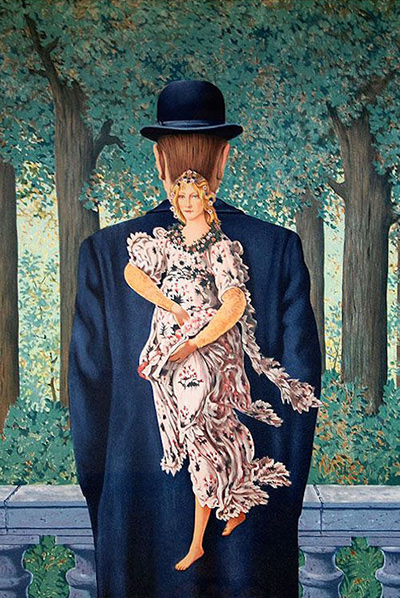René Magritte (born 1898, died 1967) is probably one of the best known Surrealist artists and is particularly famous for his iconic painting; ‘The Son of Man’, featuring a figure in a bowler hat with an apple masking his face.
Magritte was born and died in Belgium and was attracted to the Surrealist movement whilst in Paris in 1925. Surrealist art typically involves odd juxtapositions and dreamlike representations and in his 1956 painting; ‘Ready Made Bouquet’ (or ‘Le Bouquet Tout Fait’) Magritte certainly provides these elements. The painting is of a figure in a black coat and bowler hat.
One assumes it is a man but this is not absolutely clear as the figure has its back towards us. The figure is standing in front of a stone balcony, looking out over a landscape of trees and greenery. Over the figure’s coat, running down much of the length of the picture, Magritte has superimposed a beautiful, delicate, female figure.
The woman is clearly a reproduction of Flora; a figure in the 15th Century painting; ‘The Allegory of Spring’ (or ‘La Primavera’), painted by Botticelli and held in the Uffizi Gallery in Florence, Italy. Magritte has denied the viewer full access to the larger figure, just as he did with ‘The Son of Man’, and has therefore evoked a mystery. What is hidden from view? Is it something important? This was a tactic Magritte used in a number of his paintings. ‘Ready Made Bouquet’ is illustrative in style and the images are clearly portrayed.
So Magritte offers a paradox – all is clear and yet not all is visible. Unlike many Surrealist painters, who preferred themes more concerned with the unconscious or subconscious state, Magritte appeared to be more interested in the world around him. The men in bowler hats may represent self-portraits and images of his wife and their home are also evident in his work, suggesting that he drew his inspiration from ordinary life. Again, Magritte presents an intriguing paradox to those viewing his work. How can the ordinary become so extraordinary? It is little wonder that he achieved such popularity and that prints and lithographs of his work hang on so many walls.




